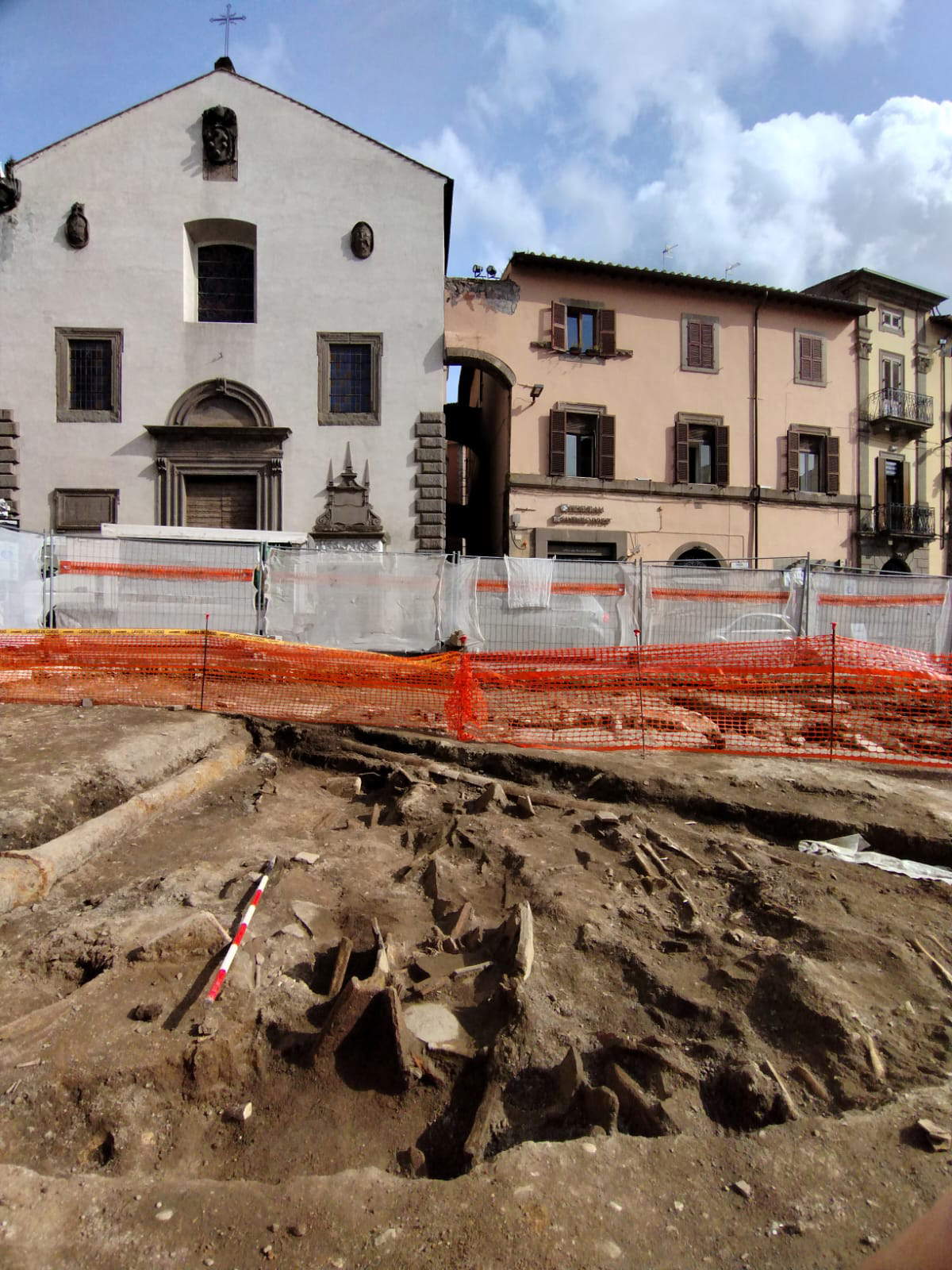The documentation operations related to the preventive archaeological investigations conducted in Piazza del Plebiscito, in the heart of Viterbo, are coming to an end these days. An intervention planned as part of the redevelopment works of the paving of the square, which has returned results of great historical and scientific relevance. In parallel with the final stages of the survey, operations are also underway to cover the emerged evidence, so that the area can be handed over to Sector VI - Public Works and Maintenance of the City of Viterbo as early as Monday, April 14.
What emerged in the archaeological site goes far beyond expectations, returning a stratified and complex picture of urban life in one of the most significant areas of Viterbo’s historic center. Indeed, the discoveries include numerous evidences that are intertwined with the deep history of the city: from medieval burials to wall structures that predate the current layout of the square, to pipelines that testify to the continuous reorganization of urban space over the centuries.
One of the most impactful finds is the one related to the cemetery of the church of Sant’Angelo in Spatha, a reality hitherto known only through documentary sources and never investigated in the field. Archaeologists have identified as many as 45 depositions, both male and female, arranged on several stratigraphic levels. To these were added five graves referable to children. The burials, as was typical in the medieval period, were laid in simple pits, in some cases finished with a tile covering and roofing, but devoid of grave goods. This aspect, in addition to being part of the customs of the time, offers valuable information on the funerary practices in use in the town community of the time.


Alongside the tombs, masonry of particular interest has emerged, suggesting a different urban layout prior to the current arrangement of the square. These structures, probably referable to rooms or buildings not yet fully identified, testify to a long and articulated history of occupation of the area, which is confirmed as a crucial junction in the urban morphology of Viterbo. The layout of the masonry offers insights into a better understanding of the transformations undergone by this space over the centuries, returning hitherto unpublished elements to historical and archaeological research.
No less significant are the stretches of pipelines that were found during the investigations. Their presence, distributed in several places on the site, attests to the continuous stratification and functional adaptation of this portion of the city. Indeed, hydraulic infrastructures often survive architectural and urban reorganizations, constituting an eloquent trace of the daily life and practical needs of the urban community over time.
In view of thetechnical impossibility of leaving archaeological evidence in view - also so as not to compromise the continuation of public works - detailed and technologically advanced documentation was undertaken. In addition to the usual photographic shots, a laser scanner survey of the entire area affected by the excavation was carried out. This methodology makes it possible to acquire data on each structure with very high precision, ensuring a virtual and permanent reconstruction of the evidence, which, while being covered over, will not be lost in the memory of research.
The Soprintendenza Archeologia, Belle Arti e Paesaggio for the province of Viterbo and southern Etruria, which coordinated the investigations, has expressed its desire to return to the citizenry what emerged during the excavation. The intention is to elaborate a multimedia narrative that can be the prerogative of everyone, offering a fascinating and unprecedented cross-section of Viterbo’s history. In addition to this, it is planned - upon completion of the study of the materials found, particularly bone remains and ceramics - to organize a public exhibition. This event will provide an important opportunity to raise public awareness of the wealth of heritage hidden under the city’s streets and the value of preventive archaeological research. Piazza del Plebiscito, in its current and renovated face, will thus continue to be a living space of the city, but now with an extra wealth of knowledge, digitally preserved and ready to be shared.
 |
| Viterbo, with the works for the new paving of the square discovered medieval tombs and ancient walls |
Warning: the translation into English of the original Italian article was created using automatic tools. We undertake to review all articles, but we do not guarantee the total absence of inaccuracies in the translation due to the program. You can find the original by clicking on the ITA button. If you find any mistake,please contact us.